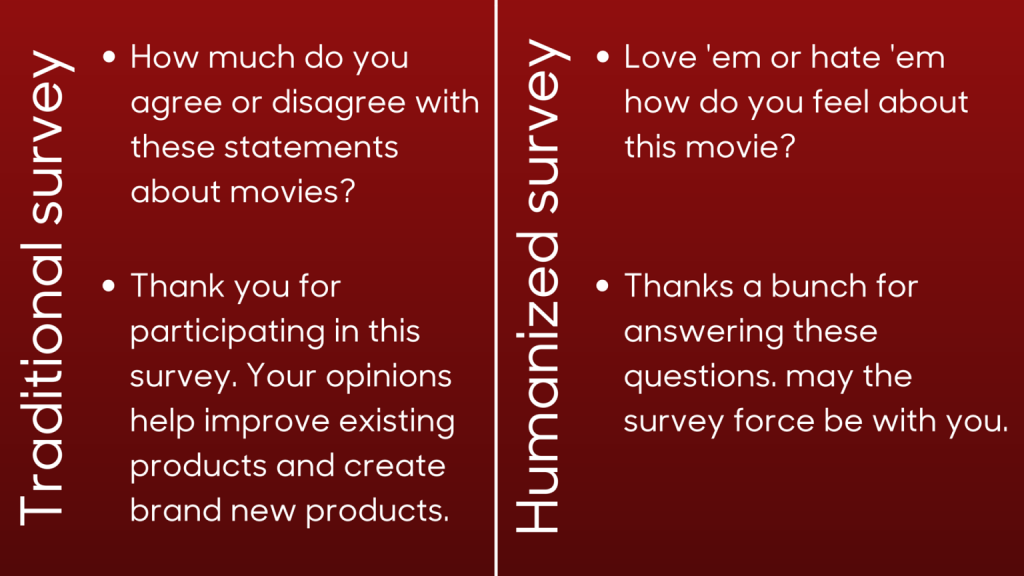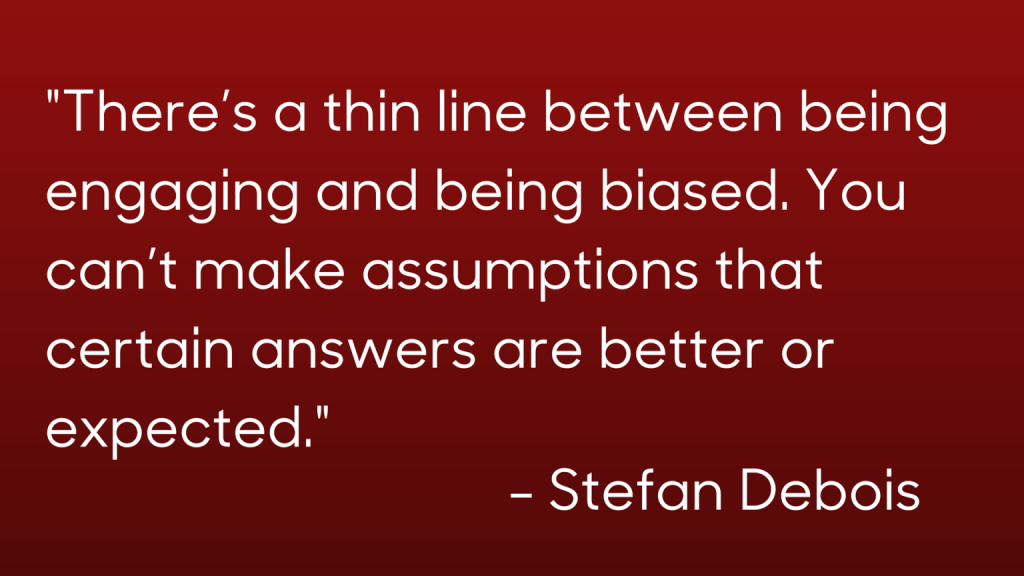Improve your survey with humanized questions
Asking the right questions can be quite a tricky thing to do. Researchers have to be really clear and precise about what they want to know. This often results in questions like:
“Based on any advertising, such as TV commercials, roadside billboards, banners on Internet Web sites, or other similar forms of advertising, please list in the text box below the products or types of products that you yourself have seen publicly advertised between January 1, 2013 and December 31, 2013. (Please type your answer in the box below.)”
Not quite a question that you like to read, let alone answer. So how can you engage people and still be clear about what you want to know? You could try gamification. Or even add some fun tasks, elements, visuals or jokes. (Get inspiration to unbore your common survey.) But unless you are a designer or a stand-up comedian… Couldn’t we just write more human survey questions?
Our definition of the human language
“Just” write better survey questions? Talking about a Captain Obvious…
Allow me to explain.
For starters, why not use simpler and more modern language? The kind of language human beings actually use. There’s a time and place to use corporate language, but most of our data comes from the average John and Jane Doe. Instead of profiling yourself as a corporation, get on the same level as your audience. Start a conversation.

Still don’t know where to begin? Don’t worry, I’ve got your back! Let’s indulge ourselves in the magical world of human survey questions with 7 very easy, very actionable tips:
1. Timing is everything
Before we handle the questions themselves, we have to consider the order in which we are going to ask them. There’s one golden rule here: always start with the easy questions! Ease your respondent into it. And don’t ask too many questions either. A 100 question survey? Ain’t nobody got time for that! 7 questions will do, after that the respondent has only one goal: finish the survey ASAP!
2. Keep it short
Time is a valuable good. Make your questions short, forget all the fancy words and just write the way you talk: naturally. And then try to get rid of at least 3 more words, kill your precious darlings! Try to avoid making your questions longer than two lines of text.

3. Write conversationally
Try to engage with your respondent, make him feel as if you are in a conversation and someone is actually interested in what he has to say. Try talking WITH him instead of talking AT him. Our post on 6 ways to make your surveys more conversational will help you out here!
You might have noticed I said “him” not “them”. Why? because even though your survey might reach thousands of people, there’s always just one person filling it out. And it’s that person we should try to engage with as personally as possible, so write for an audience of one.
Now that you have your audience, you can start asking your questions to him or her. Practice with a friend, a colleague… or with your mom, if they don’t understand your questions, nobody will.
4. One at a time
Stay focused on one subject per question. Plain and simple. “How much of your monthly income is spent on restaurant dining and entertainment?” Wouldn’t teach you a lot, because people might spend a lot on one thing and nothing on the other and you wouldn’t know.
Tackle the issue before it occurs by splitting the question in two.
“How much of your monthly income is spent on:
– restaurant dining?
– other (non-food) entertainment?”
You’ll find all the knowledge you need on which questions will get you the right answers in our essential guide.
5. Cover your bases
Make sure you cover all the possible answers people might give you. That doesn’t mean giving your respondent a hundred options to choose from though. Simply list the most common ones and include an “other” or “don’t know” option.
6. Make sure you don’t overlap
So you think you’ve covered everything? Well then it’s time to take it to the next level: check if your answers don’t overlap or if there are gaps. Especially when you don’t allow multiple answers. How do you know if your answers overlap? Maybe the following question can illustrate the issue.
“How many movies did you watch last month?
0 – 3
3 – 6
6 – 9
9 or more”
What do you do if you watched 3 movies? There are two options, which means your answers overlap. Make sure your questions are mutually exclusive. Revising and testing your survey before sending them out will prevent this type of mistake.
7. Avoid bias
And finally: stay cautious and avoid bias at all times. There’s a thin line between being engaging and being biased. You can’t make assumptions that certain answers are better or expected.
For example, a respondent would be more inclined to truthfully answer:
“have you ever lined up at a movie theatre so you could be among the first to watch a new film?” instead of “Are you one of those people who lines up at the cinema to be the first to see a new film?”
The latter is a bit suggestive, isn’t it? The same applies to humor, what you think is funny, isn’t always funny to others. So be cautious!

Disagree? Leave your comments down below!
Want to learn even more?
Here’s some more reading material on the matter: How to select the right types of survey questions – The essential guide




2 Responses
I think these good ideas illustrate this isn’t a science. Sure they would work really well in some context, but not at all well in some others. There are core bad practices, like overlapping and bias questions, but beyond that, the humanising questions principle is a bit hit and miss. You don’t want to make your survey look like it was written for children to complete. You have to maintain some level of professionalism in your writing.
Looks like this have some time published. But i liked enough to make a comment, so, would love to see some more examples but understand the idea. I’ll be applying in my next survey for my thesis. Thanks a lot